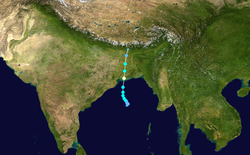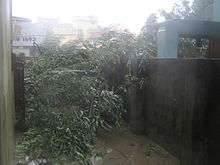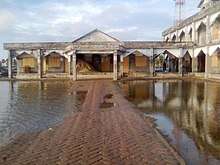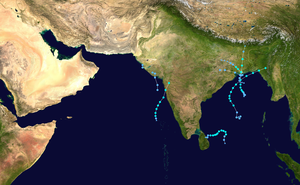Cyclone Aila
Cyclone Aila (JTWC designation: 02B, also known as Severe Cyclonic Storm Aila) was the second named tropical cyclone of the 2009 North Indian Ocean cyclone season. Warned by both the Regional Specialized Meteorological Center (RMSC) and Joint Typhoon Warning Center (JTWC), Aila formed over a disturbance over the Bay of Bengal on May 23, 2009 and started to intensify and organize reaching sustained wind speeds of 110 kmh (70 mph). It was the worst natural disaster to affect Bangladesh since Cyclone Sidr in November 2007. A relatively strong tropical cyclone, it caused extensive damage in India and Bangladesh.
| Severe cyclonic storm (IMD scale) | |
|---|---|
| Category 1 tropical cyclone (SSHWS) | |
 Severe Cyclonic Storm Aila at peak intensity | |
| Formed | May 25, 2009 |
| Dissipated | May 27, 2009 |
| Highest winds | 3-minute sustained: 110 km/h (70 mph) 1-minute sustained: 120 km/h (75 mph) |
| Lowest pressure | 968 hPa (mbar); 28.59 inHg |
| Fatalities | 339 total |
| Damage | At least $1 billion (2009 USD) |
| Areas affected | India, Bangladesh |
| Part of the 2009 North Indian Ocean cyclone season | |
The storm was responsible for at least 339 deaths across Bangladesh and India; more than 1 million people were left homeless. Health officials in Bangladesh confirmed a deadly outbreak of diarrhoea on 29 Formation Alert being issued early the next day by the JTWC as the low level circulation center had become stronger and more defined.[1] Later that morning RSMC New Delhi designated the disturbance as Depression BOB 02.[2]
During the day Depression BOB02 continued to slowly intensify until early the next day when it was upgraded to a Deep Depression by RSMC New Delhi, and designated as Tropical Cyclone 02B by the JTWC.[3][4] This came as satellite imagery had shown further organization of the depression.[3] Later that day, RSMC New Delhi reported that the deep depression had intensified into May, with more than 7,000 people being infected and four dying. In Bangladesh, an estimated 20 million people were at risk of post-disaster diseases due to Aila.
Meteorological history

Late on May 21, 2009, the Joint Typhoon Warning Center reported that a Tropical Disturbance had persisted about 950 kilometres (590 mi) to the south of Kolkata, in India and had developed within the Southwest Monsoon.[5][3] The disturbance at this time had a broad and poorly organized area of deep convection, which was located to the southeast of the low level circulation center which had consolidated into a single circulation during the previous 12 hours.[5] Environmental analysis indicated that the system was in an area of favorable conditions to develop with low vertical wind shear and warm sea surface temperatures.[5] During May 22, 2009, the disturbance developed further with a Tropical Cyclone a Cyclonic storm and had been named as Aila whilst located about 350 kilometres (220 mi) to the southeast of Sagar Island.[6] Aila became a severe cyclonic storm at 06UTC on May 25 and made landfall at its peak intensity (60kt, 967hPa) between 08 and 09UTC.[7]
Preparations
Officials in India evacuated thousands of residents from coastal areas ahead of Cyclone Aila.[8] In addition, several warning alerts were issued before the cyclone hit Kolkata; however, no alarm bells were rung.[9]
In the Bhola District of Bangladesh, an estimated 500,000 people evacuated to higher areas and shelters as Aila neared landfall. Tourists were advised to stay in their hotels due to the short amount of time to prepare for the storm.[10]
Impact
India

In India, at least 149 people were killed,[11][12] two by electrocution, and hundreds others were left homeless as torrential rains led to flooding. High winds uprooted numerous trees, blocking roads throughout the region.[13][14] More than 15,000 people in eight villages were reportedly isolated from relief crews by severe flooding.[15] At least 18 of the 45 fatalities in West Bengal were in Kolkata, the region where Aila made landfall. All transit systems in the city of Kolkata were halted and daily life was at a standstill due to the storm.[16] The areas and districts affected by the cyclone in West Bengal include East Midnapore, Howrah, Hooghly, Burdwan, South 24 Parganas and Kolkata.[12] In the West Bengal state, more than 100,000 people were left homeless as a result of Aila.[17] At least 100 river embankments were breached by storm surge produced by the cyclone. Throughout the country, at least 150,000 people were left homeless.[18] In northern areas of the state, heavy rains triggered numerous landslides in Darjeeling that killed 22 people and left 6 others missing. At least 500 homes were also damaged in the area.[19] At least 50,000 hectares of agricultural land was lost during the storm, costing an estimated Rs. 125 crore (US$26.3 million). Throughout the state, an estimated 40,000 homes were destroyed and 132,000 others were damaged. At least 350,000 people affected by Aila.[20][21] Later reports indicated that upwards of 2.3 million were displaced by the storm as 175,000 homes were destroyed and 270,000 were damaged.[22]
The outer bands of the storm also produced torrential rains and high winds in eastern portions of Orissa state, with the heaviest rainfall being recorded at Paradip at 260 mm (10 in) and winds peaked at 90 km/h (56 mph). Numerous trees were uprooted and power lines were downed, causing widespread power outages. High waves produced by the storm inundated coastal villages, forcing residents to evacuate to safer areas. Roads were also blocked by floodwaters or debris, hampering relief efforts.[23] An estimated 1,000 acres (4.0 km2) of Orissa cropland were lost due to Aila.[24]
The remnants of Aila produced gusty winds and heavy rains in the eastern Indian state of Meghalaya between May 25 and 26. Rainfall amounts peaked at 213.4 mm (8.40 in) and winds reached 60 km/h (37 mph). Several homes were damaged in the area and power was cut due to fallen trees and power lines. No injuries were reported in the state.[25] Several streets were flooded and some homes were reported to have standing water.[26]
Bangladesh

Torrential rains from Aila resulted in 190 fatalities and at least 7,000 injuries across the Khulna and Satkhira Districts.[27] Across 11 of the nation's 64 districts, approximately 600,000 thatched homes, 8,800 km (5,500 mi) of roads, 1,000 km (620 mi) of embankments, and 123,000 hectares (300,000 acres) of land were damaged or destroyed.[28][29] Approximately 9.3 million people were affected by the cyclone, of which 1 million were rendered homeless.[27][30] One year after the storm, 200,000 people remained homeless.[31] Total losses amounted to 89.46 billion taka (US$1 billion).[32]
More than 400,000 people were reportedly isolated by severe flooding in coastal regions of Bangladesh. Numerous villages were either completely submerged in floodwaters or destroyed.[10] Dozens of people are reportedly missing throughout the country.[33] A storm surge of 3 m (10 ft) impacted western regions of Bangladesh, submerging numerous villages. Several rivers broke through embankments, causing widespread inland flooding. In Dacope Upazila alone, more than 50,000 people were left homeless. Despite warnings to remain at port, numerous fishing vessels sailed into the storm. Port officials stated that more than 500 fishermen had gone missing since the storm made landfall.[34] In Patuakhali, a dam broke and submerged five villages. Numerous houses were destroyed by the subsequent flooding and tens of thousands of people were left stranded in the villages. In Chandpur, two pontoons sank while docked in port.[35] An estimated 58,950 animals were killed by the storm with up to 50,000 deer missing. On the island of Nizum Dwip, nearly all structures were severely damaged or destroyed, leaving roughly 20,000 people homeless.[36]
Environmental impact
The Sunderbans, a region which houses 265 of the endangered Bengal tigers, was inundated with 6.1 m (20 ft) of water. Dozens of the tigers are feared to have drowned in Aila's storm surge along with deer and crocodiles. As of 27 May 2009, one tiger has been found alive; it was found in a waterlogged cowshed following the cyclone's landfall. Additionally the forest remains under an estimated 2.4 m (7.9 ft) of water.[37] On 27 May, conservationists have begun a search for the tigers throughout the forest. The search teams were supplied with fresh drinking water for the tigers as their natural water source was inundated with salt water from Aila's storm surge.[38]
Government Steps
India
State Government in co-operation with the central counterparts took up the rescue and the rehabilitation program. Army was deployed to the affected areas. The next day, the army used helicopters to provide food to the affected population. About 2,500 troops were deployed to West Bengal on May 26, 2009.[39] Several naval relief teams were deployed to the Sunderbans region where an estimated 400,000 people were marooned by flooding.[40] Roughly 100 relief camps were established in West Bengal shortly after the storm passed.[41] On 27 May, 400 troops form the National Disaster Response Force were deployed to the state for relief operations.[42] The Government of India released Indian rupee 10,000,000 (US$209,775) in relief funds to the affected areas on 26 May. Two MI-17 helicopters were also sent to air-drop food supplies to the worst affected areas in West Bengal.[43]
Bangladesh
Immediately following the storm, a 33-member team of the Bangladesh Navy was deployed to the affected regions. The Red Cross also quickly responded, supplying water purifying tablets and other relief items. The Deputy Commissioner of Satkhira district allocated ten tonnes of rice and Tk.100,000 (US$1,450) in immediate relief funds for that district.[34] The government later allocated Tk. 1.2 million (US$17,143) and 1,000 tonnes of rice for the affected areas.[44] These amounts further increased to Tk. 12.3 million (US$175,714) and 2,500 tonnes of rice.[45]
Five days following the impacts of Aila, the Bangladeshi Health Organization confirmed that a widespread outbreak of diarrhea which has infected over 7,000 people. Another outbreak of water borne diseases, namely dysentery, has infected over 3,000 people. At least two people have been confirmed to have died from diarrhea and two other fatalities were reported.[46] Officials feared that the outbreak would lead to many fatalities in isolated areas that have not received aid and have been without food and clean water for nearly a week.[47]
In comparison to earlier cyclones, that of similar magnitude, Cyclone Aila caused lower death toll due to implementation of efficient early warning systems, cyclone shelters and disaster relief allocation system. The Government of Bangladesh was praised domestically and internationally for its implementation of effective disaster management projects that have reduced death tolls in Cyclone Aila and future cyclones that have struck the country it since. Cyclone Aila has been described as a benchmark of Bangladesh's success in implementation of effective disaster management system.[48] The joint effort of the Government and NGOs to support the post-disaster recovery was also remarkable but criticized due to lack of comprehensive inclusion of pre-disaster vulnerability reduction measures.[48]
See also
- 2009 North Indian Ocean cyclone season
- Cyclone Mora- a strong tropical cyclone in May 2017 that devastated Bangladesh and neighbouring countries.
References
- "Tropical Cyclone Formation Alert 23-05-2009 05z". Joint Typhoon Warning Center. May 23, 2009. Archived from the original on May 23, 2009. Retrieved May 25, 2009.
- "C Wind Advisory 2009-05-23 06z". India Meteorological Department. May 23, 2009. Archived from the original on May 23, 2009. Retrieved May 25, 2009.
- "JTWC Advisory 24-05-2009 00z". Joint Typhoon Warning Center. May 24, 2009. Archived from the original on May 24, 2009. Retrieved May 25, 2009.
- "Tropical Weather Outlook 2009-05-24 06z". India Meteorological Department. May 24, 2009. Archived from the original on May 24, 2009. Retrieved May 25, 2009.
- "Significant Tropical Weather Advisory for the Indian Ocean 2009-05-21 18z". Joint Typhoon Warning Center. May 21, 2009. Archived from the original on May 21, 2009. Retrieved May 23, 2009.
- "Tropical Storm Aila Advisory 1 24-05-09 12z". India Meteorological Department. May 24, 2009. Archived from the original on May 24, 2009. Retrieved May 25, 2009.
- "Severe Cyclonic Storm, AILA: A Preliminary Report" (PDF). Archived from the original (PDF) on June 12, 2009. Retrieved June 5, 2009.
- "2 killed in India as cyclone Aila approaches". The Daily Star. Associated Press. May 25, 2009. Retrieved May 25, 2009.
- "Storm Aila kills 32 across Bengal". The Times of India. May 26, 2009. Retrieved May 26, 2009.
- "Cyclone slams Bangladesh and India, 33 dead". Reuters. May 25, 2009. Retrieved May 25, 2009.
- "West Bengal: Cyclone toll rises to 45, rescue ops begin". The Times of India. May 26, 2009. Retrieved May 26, 2009.
- "21 killed, over a lakh hit as cyclone Aila strikes". Business Standard India. Press Trust of India. May 25, 2009. Retrieved May 25, 2009.
- "17 killed as cyclonic storm hits Kolkata". Rediff News. May 26, 2009. Retrieved May 26, 2009.
- "UPDATE 4-Cyclone slams Bangladesh and India, 33 dead". Reuters. May 26, 2009. Retrieved May 26, 2009.
- "Cyclone Aila lashes eastern India, Bangladesh". CBC News. Associated Press. May 25, 2009. Retrieved May 25, 2009.
- "18 killed as cyclone Aila hits West Bengal coast". The Wall Street Journal. Associated Press. May 25, 2009. Retrieved May 25, 2009.
- "Aila claims 29 in B". The Statesman. Kolkata. Statesman News Service. May 26, 2009.
[Dateline: May 25] Preliminary reports say that at least 1 lakh people were rendered homeless. Of them 80,000 people have been rescued till late this afternoon, Mr Dasgupta [West Bengal Minister for Finance] said.
- "Worst storm in 20 years hits Kolkata". The Indian Express. May 25, 2009. Retrieved May 25, 2009.
- "22 killed in Darjeeling landslides after cyclone". Sify News. May 27, 2009. Archived from the original on August 18, 2016. Retrieved May 27, 2009.
- Biswabrata Goswami (May 27, 2009). "Aila brings more than damage in Tamluk". The Statesman. Kolkata.
[Dateline: May 26] Mr Mamud Hossain, saha-sabhadhipati of the zilla parishad, said ... the number of affected people would be not less than 3.5 lakh ... The Midnapore East district zilla parishad has claimed that over 50,000 ha of crop land has been ruined due to a large scale inundation by river and sea waters. They have also estimated that the loss would be around Rs125 crore.
- "Toll at 81 as Aila hits North Bengal". The Indian Express. Press Trust of India. May 27, 2009. Retrieved May 27, 2009.
- Sujoy Dhar (May 27, 2009). "Millions displaced by cyclone in India, Bangladesh". Reuters. Retrieved May 27, 2009.
- "Tidal waves lash Orissa coast". The Statesman. Kolkata. May 26, 2009.
[Dateline: May 25] Parts of coastal Orissa ... heavy rains accompanied by high-velocity winds ... gale with speed as high as 80-90 kmph uprooted a large number of trees in Jagatsinghpur, Kendrapara and Cuttack districts, blocking several roads and disrupting vehicular movement, [official sources] said. Life was paralysed in Satabhaya and Kanhupur villages in Kendrapara district after tidal waves lashed into human settlements since yesterday, forcing residents to shift to higher grounds and safer places. Water-logging severely affected road traffic in several places including Cuttack, Paradip and Jagatsinghpur ... In Bhubaneswar, power supply was disrupted for about seven hours in Bapuji Nagar, Ashok Nagar, Patia, Chandrasekharpur and Jayadev Vihar localities this morning ... The port town of Paradip witnessed its highest rainfall of 26 cm today.
- "Coastal Orissa badly hit by cyclonic storm". Hindustan Times. Press Trust of India. May 25, 2009. Retrieved May 25, 2009.
- "Heavy rains lash Assam, Meghalaya". Sifly News. May 26, 2009. Retrieved May 26, 2009.
- "Cyclone Aila brings monsoon to North-East". The Times of India. May 26, 2009. Retrieved May 26, 2009.
- "Still feeling the toll of Cyclone Aila". ReliefWeb. Islamic Relief. June 5, 2014. Retrieved October 15, 2015.
- "Cyclone Aila losses in Bangladesh estimated at 269 mln USD". Dakha, Bangladesh: ReliefWeb. Xinhua News Agency. June 22, 2009. Retrieved October 15, 2015.
- "Bangladesh: Cyclone Aila recovery slower than Sidr". Dakha, Bangladesh: Integrated Regional Information Networks. July 23, 2009. Retrieved October 15, 2015.
- "Bangladesh: Hundreds of thousands still homeless three months after cyclone Aila". Dakha, Bangladesh: ReliefWeb. Emergency Capacity Building Project. August 24, 2009. Retrieved October 15, 2015.
- "Bangladesh: In pictures: One year on from Cyclone Aila". ReliefWeb. BBC. May 25, 2010. Retrieved October 15, 2015.
- Ali Asif Shawson (May 20, 2020). "Cyclone Amphan: Bangladesh may face losses worth Tk12,744cr". Dhaka Tribune. Retrieved May 20, 2020.
- "Cyclone Aila claims 28 lives". Radio Netherlands. May 25, 2009. Retrieved May 25, 2009.
- "18 killed as Cyclone Aila lashes coast". The Daily Star. May 26, 2009. Retrieved May 26, 2009.
- "Wind, rains batter coastal regions". Bangladesh News 24. May 25, 2009. Retrieved May 25, 2009.
- "Death toll rises to 91 in cyclone-hit Bangladesh". Xinhuanet. Xinhua News Agency. May 26, 2009. Retrieved May 26, 2009.
- "Cyclone Aila swallows Sunderbans tigers". The Times of India. May 27, 2009. Retrieved May 27, 2009.
- "Fears for rare tigers after SAsia cyclone". Dawn. May 27, 2009. Retrieved May 27, 2009.
- "Centre rushes 2500 troops for relief work in cyclon hit WB". The Economic Times. May 26, 2009. Retrieved May 26, 2009.
- Anis Ahmed (May 26, 2009). "Cyclone Aila kills nearly 120 in Bangladesh, India". Portfolio. Retrieved May 26, 2009.
- "Cyclone Aila Lashes Eastern India, Bangladesh". VOA News. May 26, 2009. Retrieved May 26, 2009.
- "Centre sends National Disaster Response Force". The Hindu. May 27, 2009. Retrieved May 27, 2009.
- "Cyclone Aila toll rises to 87 in West Bengal". Thaindian News. May 27, 2009. Retrieved May 27, 2009.
- "Cyclone leaves 81 people killed, 2.6 mln affected in Bangladesh". Xinhuanet. Xinhua News Agency. May 26, 2009. Retrieved May 26, 2009.
- "Cyclone kills 91 in Bangladesh, rescue operation continues". Xinhuanet. Xinhua News Agency. May 27, 2009.
- "Diarrhoea outbreak after Bangladesh cyclone". Agence France-Presse. May 31, 2009. Archived from the original on May 31, 2009. Retrieved May 31, 2009.
- Nita Bhalla (May 29, 2009). "Disease fears mount after cyclone Aila". Reuters. Retrieved May 31, 2009.
- Sadik, Md. Shibly; Nakagawa, Hajime; Rahman, Rezaur; Shaw, Rajib; Kawaike, Kenji; Fujita, Kumiko (2018). "A Study on Cyclone Aila Recovery in Koyra, Bangladesh: Evaluating the Inclusiveness of Recovery with Respect to Pre–disaster Vulnerability Reduction". International Journal of Disaster Risk Science. 9: 28–43. doi:10.1007/s13753-018-0166-9.
External links
| Wikimedia Commons has media related to Cyclone Aila. |
